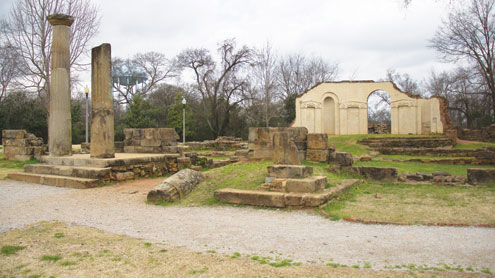 A member of the legislature once discussed Alabama law with his colleague in his office, and a young woman studied mathematics down the hall. In the main rotunda downstairs, UA professor Frederick A. P. Barnard once tinkered with his Foucault pendulum, and a young couple said, “I do” a few yards away.
A member of the legislature once discussed Alabama law with his colleague in his office, and a young woman studied mathematics down the hall. In the main rotunda downstairs, UA professor Frederick A. P. Barnard once tinkered with his Foucault pendulum, and a young couple said, “I do” a few yards away.
Tuscaloosa’s historic Capitol Park has a rich history that the stone building remnants nestled in the grass only begin to expose. From the site of the Alabama state capitol to Alabama Central Female College to a public green space, Capitol Park is an important part of Tuscaloosa’s history.
The capitol building that once stood on the grounds of Capitol Park was built in 1826 when Tuscaloosa was named Alabama’s third capital. It was preceded by territorial capital St. Stephens and the first state capital, Cahaba. The building was completed in 1829 with a $100,000 price tag.
Tuscaloosa County Preservation Society Executive Director Katherine Mauter said this amount of money was a significant investment.
“In modern day terms, it would have cost millions when you factor in inflation,” Mauter said. “That really says something.”
According to by G. Ward Hubbs’ book “Tuscaloosa: Portrait of an Alabama County,” Tuscaloosa’s becoming the state capital played a great role in its becoming what it is today.
“Tuskaloosa is improving rapidly. Our state house is now nearly complete and will be, I think, a more elegant one than any other state can boast of. It is built under the superintendence of Mr. Nichols, an English architect,” said Z.B. Snow in a letter to his brother dated Oct. 11, 1829.
William Nichols, the architect Snow spoke of, also designed the University of Alabama and designed the three-story building that housed all three branches of Alabama state government while Tuscaloosa was the capital from 1826 to 1847.
When the state capital was moved to more centralized Montgomery in 1847, the old capitol building was deeded to the University of Alabama and remained an important part of the Tuscaloosa community.
Barnard was one of the few who used the capitol building during the 10 years following the capital move. He began the building’s use for education by doing experiments with Foucault pendulums, devices that demonstrated the rotation of the earth.
In 1857, the educational usage of the building continued when UA leased the property to the Alabama Central Female College. The first class graduated in 1859.
In 1923, an intense fire burned the capitol beyond ability to salvage it. Community members collected bricks, stone and other ornaments from the destroyed building for use in their home, and the site was cleared. The ownership was reverted back to UA, and it remained an empty lot for nearly 70 years.
Thrift Foundation, Inc. purchased the site from UA in 1988 and gave it to the city of Tuscaloosa for development. An archeological excavation began in 1989, exposing the outline of the capitol that can be seen today, and in 1992, Capitol Park as it is known today was opened.
Mauter said it is a great place for citizens to visit.
“It is so important historically, and you get to go any time you want. It is not something you have to plan,” Mauter said. “It is an important place and a great place because you can get married there or have a picnic. It is a beautiful piece of property and it is just a happy place. There is no mature way to say it: It is just a happy place.”







